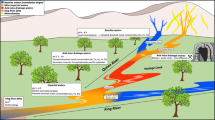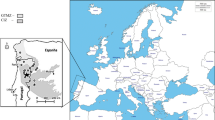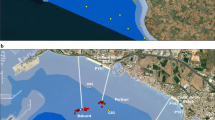Abstract
In 2005 and 2006, hydrogeochemical study was carried out in the bipartite Wiśniówka Mała pit lake of the Holy Cross Mountains (south-central Poland). This is the largest acidic water body in Poland. This report presents the element concentrations in the water and sediment, stable sulfur and oxygen isotope ratios in the soluble sulfates, and stable oxygen isotope ratio in the water. The scope of the investigation also encompassed mineralogical examinations (scanning electron microscope, X-ray diffraction) of the sediment. The results of this study show that there is a spatial and temporal variability in concentrations of most elements and sulfur isotope ratios in the examined pit lake. The water of the western pond displayed a lower pH with a mean of 3.73 and higher conductivity (390 μS cm−1) as well as higher concentrations of sulfates (156 mg L−1) and most of the cations and anions. The concentrations of Fe2+ and Fe3+ averaged 0.8 and 0.4 mg·L−1. In contrast, the eastern pond water revealed a higher pH (mean of 4.36), lower conductivity (293 μS cm−1) and lower sulfate (90 mg L−1) and trace metal levels. Similar variations were recorded in the stable sulfur isotope ratios. The δ34SV-CDT(SO4 2−) values in the water of the western pit pond were in the range of −6.7 to −4.6‰ (mean of −5.6‰), whereas that in the eastern pit pond ranged from −2.2 to −0.9‰ (−1.6‰). The alkalinity of the entire lake water was below 0.1 mg·L−1 CaCO3. No distinct difference in the δ18OV-SMOW(SO4 2−) was noted between the western and eastern pit ponds. Compared to the Purple Pond in the Sudetes (Poland) and similar sites throughout the world, the examined pit lake is highlighted by distinctly low concentrations of sulfates, iron and other trace metals. Based on this and other studies performed in the Holy Cross Mountains, a conclusion can be drawn that the SO4 2− in the Wiśniówka Mała pit lake water is a mixture of SO4 2− derived from the following sources: (1) pyrite oxidation (especially in the western pond water), (2) leaching of soluble sulfates from soils and waste material, as well as (3) subordinate deposition of airborne sulfate precipitation.



Similar content being viewed by others
References
Aguilar J, Dorronsoro C, Fernández E, Fernández ZJ, Garcia I, Martin F, Simón M (2004) Soil pollution by a pyrite mine spill in Spain: evolution with time. Environ Pollut 132:395–401
Balci N, Shanks III WC, Mayer B, Mandernack KW (2007) Oxygen and sulfur isotope systematics of sulfate produced by bacterial and abiotic oxidation of pyrite. Geochim Cosmochim Acta 71:3796–3811
Ball JW, Nordstrom DK (1989) Final revised analyses of major and trace elements from acid mine waters in the Leviathan mine drainage basin, California and Nevada, October 1981 to October 1982. US Geology Survey Water-Resources Investigations Report 89–4138
Czarnocki J (1950) Geology of the Łysogóry region in relation to the occurrence of iron ore deposit at Rudki. Pr Państw Inst Geol (Pol Geol Inst Prof Pap) 1:3–404
Epstein S, Mayeda T (1953) Variation of 18O content of waters from natural sources. Geochim Cosmochim Acta 4(5):213–224
Gałuszka A (2005) The chemistry of soils, rocks and plant bioindicators in three ecosystems of the Holy Cross Mountains, Poland. Environ Monit Assess 110:55–70
Garrels RM, Thompson ME (1960) Oxidation of pyrite in ferric sulfate solution. Am J Sci 258:57–67
Geller W, Klapper H, Schultze M (1998) Natural and anthropogenic sulfuric acidification of lakes. In: Geller W, Klapper H, Salomons W (eds). Acidic mining lakes. Springer, Berlin, pp 3–15
Habicht KS, Canfield DE (1997) Sulfur isotope fractionation during bacterial sulfur reduction in organic-rich sediments. Geochim Cosmochim Acta 61:5351–5361
Habicht KS, Canfield DE, Rethmeier J (1998) Sulfur isotope fractionation during bacterial sulfur reduction and disproportionation of thiosulfate and sulfite. Geochim Cosmochim Acta 62:2585–2595
Hałas S, Szaran J (2004) Use of Cu2O–NaPO3 mixtures for SO2 extraction from BaSO4 for sulfur isotope analysis. Isotopes Environ Health Stud 40(3):229–231
Hałas S, Szaran J, Czarnacki M, Tanweer A (2007) Refinements in BaSO4 to CO2 preparation and δ18O calibration of the sulfate reference materials NBS-127, IAEA SO-5 and IAEA SO-6. Geostand Geoanal Res 31(1):61–68
Hoefs J (1997) Stable isotope geochemistry. Springer, Berlin
Jezierski P, Szynkiewicz A, Jędrysek MO (2006) Natural and anthropogenic origin sulphate in a mountainous groundwater system: S and O isotope evidence. Water Air Soil Pollut 173:81–101
Johnson DB (2006) Biohydrometallurgy and the environment: intimate and important interplay. Hydrometallurgy 83:153–166
Knöller K, Fauville A, Mayer B, Strauch G, Friese K, Veizer J (2004) Sulfur cycling in an acid mining lake and its vicinity in Lusatia, Germany. Chem Geol 204:303–323
Kowalczewski Z, Dadlez R (1996) Tectonics of the Cambrian in the Wiśniówka area (Holy Cross Mts, central Poland). Geol Quart 40:23–46
Kroopnick P, Craig H (1972) Atmospheric oxygen: isotopic composition and solubility fractionation. Science 175:54–55
Krouse HR, Grinenko VA (eds) (1991) Stable Isotopes: natural and anthropogenic sulphur in the environment. Wiley, New York
McKibben MA, Barnes AL (1986) Oxidation of pyrite in low temperature acidic solutions: rate laws and surface textures. Geochim Cosmochim Acta 50:1509–1520
Michalik A. (2006) Influence of factors on the chemistry of spring waters in Holy Cross Mountains National Park. PhD, Faculty of Chemistry, Gdańsk Technical University (in Polish)
Migaszewski ZM (1998) Geochemistry of soils and vegetation of the Holy Cross Mts between 1994 and 1996. Geol Quart 42(1):99–110
Migaszewski ZM, Gałuszka A, Pasławski P, Starnawska E (2007) An influence of pyrite oxidation on generation of unique acid pit water: a case study, Podwiśniówka quarry, Holy Cross Mountains (south-central Poland). Pol J Environ Stud 16(3):407–421
Migaszewski ZM, Pasławski P (1996) Trace element and sulfur stable isotope ratios in soils and vegetation of the Holy Cross Mountains. Geol Quart 40(4):575–594
Mizerski W (1995) Geotectonic evolution of the Holy Cross Mts in Central Europe. Biul Państw Inst Geol (Pol Geol Inst Bull) 327:1–42
Mizerski W (2004) Holy Cross Mountains in the Caledonian, Variscan and Alpine cycles – major problems, open questions. Prz Geol (Pol Geol Rev) 52(8/2):774–779
Mizutani Y (1971) An improvement in the carbon reduction method for the oxygen isotopic analysis of sulphates. Geochem J 5:69–71
Monterroso C, Macías F (1998) Drainage waters affected by pyrite oxidation in a coal mine in Galicia (NW Spain): composition and mineral stability. Sci Total Environ 216:121–132
Moses CO, Nordstrom DK, Herman JS, Mills AL (1987) Aqueous pyrite oxidation by dissolved oxygen and by ferric iron. Geochim Cosmochim Acta 51:1561–1571
Nordstrom DK, Alpers CN (1999) Geochemistry of acid mine waters. In: Plumlee GS, Logsdon MJ (eds). The environmental geochemistry of mineral deposits, Part A. Processes, techniques, and health issues. Soc Econ Geologists, Rev in Econ Geology, vol 6A, pp 133–160
Nordstrom DK, Alpers C, Ptacek C.J, Blowers DW (2000) Negative pH and extremely acid mine waters from Iron Mountain Superfund Site, California. Environ Sci Technol 34(2):254–258
Parkhurst DL, Apello CAJ (1999) User’s guide to PHREEQC (version 2) – a computer program for speciation, batch-reaction, one-dimensional transport, and inverse geochemical calculations. US geological survey water-resources investigations report 99–4259
Parkhurst DL, Thorstenson DC, Plummer LN (1980) PHREEQC – a computer program for geochemical calculations. US geological survey water-resources investigations report 80–96
Pellicori DA, Gammons CH, Poulson SR (2005) Geochemistry and stable isotope composition of the Berkeley pit lake and surrounding minewaters, Butte, Montana. Appl Geochem 20:2116–2137
Piispanen R, Nykyri T (1997) Acidification of groundwater in water-filled gravel pits – a new environmental and geomedical threat. Environ Geochem Health 19(3):111–126
Plumlee GS, Smith KS, Montour MR, Ficklin WH, Mosier EL (1999) Geologic controls on the composition of natural waters and mine waters draining diverse mineral-deposits types. In: Filipek LH, Plumlee GS (eds). The environmental geochemistry of mineral deposits, Part A. Processes, techniques, and health issues. Soc Econ Geologists, Rev in Econ Geology, vol 6B, pp 373–407
Regenspurg S, Brand A, Peiffer S (2004) Formation and stability of schwertmannite in acidic mining lakes. Geochim Cosmochim Acta 68(6):1185–1197
Runnells DD, Shepard TA, Angino EE (1992) Metals in water – determining natural background concentrations in mineralized areas. Environ Sci Technol 26:2316–2323
Seal II RR (2003) Stable-isotope geochemistry of mine waters and related solids. Miner Soc Can (short course series) 31:303–334
Schemel LE, Kimball BA, Bencala KE (2000) Colloid formation and metal transport through two mixing zones affected by acid mine drainage near Silverton, Colorado. Appl Geochem 15:1003–1018
Schnoer JL, Stumm W (1985) Acidification of aquatic and terrestrial systems. In: Stumm W (ed) Chemical processes in lakes. Wiley Interscience, New York, pp 311–338
Simón M, Martin F, Ortiz I, Garcia I, Fernández J, Fernández E, Dorronsoro C, Aguilar J (2001) Soil pollution by oxidation of tailings from toxic spill of a pyrite mine. Sci Total Environ 279:63–74
Tarvainen T, Salminen R (1997) FOREGS geochemical mapping field and laboratory manual. Geologian tutkimuskeskus XX:1–38
Taylor BE, Wheeler MC (1994) Sulfur- and oxygen isotope geochemistry of acid mine drainage in the western United States. In: Alpers CN, Blowes DW (eds) Environmental geochemistry of sulfide oxidation, Am Chem Soc Symp Ser 550, Am Chem Soc, Washington DC, pp 481–514
Taylor BE, Wheeler MC, Nordstrom DK (1984a) Stable isotope geochemistry of acid mine drainage: experimental oxidation of pyrite. Geochim Cosmochim Acta 48:2669–2678
Taylor BE, Wheeler MC, Nordstrom DK (1984b) Isotope composition of sulfate in acid mine drainage as measure of bacterial oxidation. Nature 308:538–541
Toran L, Harris RF (1989) Interpretation of sulfur and oxygen isotopes in biological and abiological sulfide oxidation. Geochim Cosmochim Acta 53:2341–2348
Van Stempvoort DR, Krouse HR (1994) Controls of δ18O in sulfate. Review of experimental data and application to specific environments. In: Alpers CN, Blowes DW (eds). Environmental geochemistry of sulfide oxidation, Am Chem Soc Symp Ser 550. Am Chem Soc, Washington DC, pp 447–480
Wanty RB, Miller WR, Briggs PH, McHugh JB (1999) Geochemical processes controlling uranium mobility in mine drainages. In: Plumlee GS, Logsdon MJ (eds). The environmental geochemistry of mineral deposits, Part A. Processes, techniques, and health issues. Soc of Econ Geologists, Rev in Econ Geology, vol 6A, pp 201–213
Żylińska A, Szczepanik Z, Salwa S (2006) Cambrian of the Holy Cross Mountains, Poland: biostratigraphy of the Wiśniówka Hill succession. Acta Geol Pol 56(4):443–461
Acknowledgments
We are grateful to a number of colleagues of the Central Chemical Laboratory of the Polish Geological Institute in Warsaw for their assistance in performing most of the chemical analyses. The authors also thank Dr. Paul J. Lamothe of the US Geological Survey in Denver for the insightful review that considerably improved the quality of the manuscript. This study was supported by a research grant by the Ministry of Science and Higher Education (No. 2 P04G 041 30).
Author information
Authors and Affiliations
Corresponding author
Rights and permissions
About this article
Cite this article
Migaszewski, Z.M., Gałuszka, A., Hałas, S. et al. Chemical and isotopic variations in the Wiśniówka Mała mine pit water, Holy Cross Mountains (south-central Poland). Environ Geol 57, 29–40 (2009). https://doi.org/10.1007/s00254-008-1279-z
Received:
Accepted:
Published:
Issue Date:
DOI: https://doi.org/10.1007/s00254-008-1279-z




